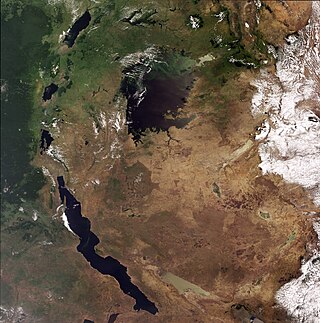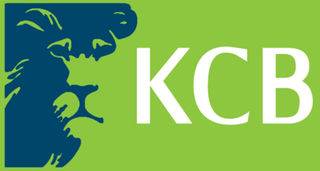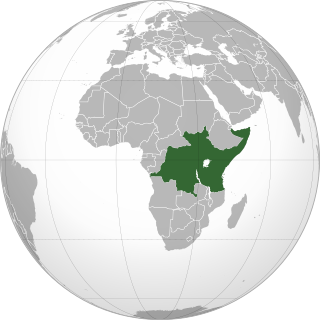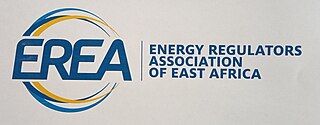Related Research Articles
There are a number of systems of transport in Burundi, including road and water-based infrastructure, the latter of which makes use of Lake Tanganyika. Furthermore, there are also some airports in Burundi.
Transport in Tanzania includes road, rail, air and maritime networks. The road network is 86,472 kilometres (53,731 mi) long, of which 12,786 kilometres (7,945 mi) is classified as trunk road and 21,105 kilometres (13,114 mi) as regional road. The rail network consists of 3,682 kilometres (2,288 mi) of track. Commuter rail service is in Dar es Salaam only. There are 28 airports, with Julius Nyerere International being the largest and the busiest. Ferries connect Mainland Tanzania with the islands of Zanzibar. Several other ferries are active on the countries' rivers and lakes.

East Africa, also known as Eastern Africa or the East of Africa, is a region at the eastern edge of the African continent, distinguished by its geographical, historical, and cultural landscape. Defined in varying scopes, the region is recognized in the United Nations Statistics Division scheme as encompassing 18 sovereign states and 4 territories. It includes the Horn of Africa to the North and Southeastern Africa to the south.

The African Great Lakes are a series of lakes constituting the part of the Rift Valley lakes in and around the East African Rift. The series includes Lake Victoria, the second-largest freshwater lake in the world by area; Lake Tanganyika, the world's second-largest freshwater lake by volume and depth; Lake Malawi, the world's eighth-largest freshwater lake by area; and Lake Turkana, the world's largest permanent desert lake and the world's largest alkaline lake. Collectively, they contain 31,000 km3 (7,400 cu mi) of water, which is more than either Lake Baikal or the North American Great Lakes. This total constitutes about 25% of the planet's unfrozen surface fresh water. The large rift lakes of Africa are the ancient home of great biodiversity, and 10% of the world's fish species live in this region.
The East-Central Africa Division (ECD) of Seventh-day Adventists is a sub-entity of the General Conference of Seventh-day Adventists, which oversees the Church's work in portions of Africa, which includes the nations of Djibouti, Eritrea, Somalia, Ethiopia, Kenya, Tanzania, Uganda, Rwanda, Burundi, South Sudan and the Democratic Republic of the Congo. It was founded in 2003 and has its headquarters is in Nairobi, Kenya. Founded in 2003. The Division membership as of June 30, 2021 is 4,588,423.

KCB Bank Kenya Limited is a financial services provider headquartered in Nairobi, Kenya. It is licensed as a commercial bank, by the Central Bank of Kenya, the national banking regulator. The bank has also been running Agency banking model.

The East African Community (EAC) is an intergovernmental organisation in East Africa. The EAC's membership consists of eight states: Democratic Republic of the Congo, the Federal Republic of Somalia, the Republics of Burundi, Kenya, Rwanda, South Sudan, Uganda, and Tanzania. William Ruto, the president of Kenya, is the current EAC chairman. The organisation was founded in 1967, collapsed in 1977, and was revived on 7 July 2000. The main objective of the EAC is to foster regional economic integration.

There are about 180,000 members of the Religious Society of Friends, or Quakers, in Africa. African Friends make up around 49% of Friends internationally, the largest proportion on any one continent. Kenya has the largest number of Quakers in a single nation—about 119,000 in the year 2017. The three main denominations of Friends, Friends United Meeting, Friends General Conference, and Evangelical Friends Church International, all have affiliated Yearly Meetings (associations) in Africa. There are also independent meetings in several African nations.

East African Breweries Limited, commonly referred to as EABL, is a Kenyan-based holding company that manufactures branded beer, spirits, and non-alcoholic beverages.

The East African Federation is a proposed federal sovereign state consisting of the eight member states of East African Community in the African Great Lakes region – Burundi, the Democratic Republic of the Congo, Kenya, Rwanda, Somalia, South Sudan, Tanzania and Uganda. The idea of this federation has existed since the early 1960s but has not yet come to fruition for several reasons. Though the federation has not yet been established, many steps have been taken to advance this goal. Institutions and governing bodies already exist for the eventual union of these nations, with representatives from all of the related nations working together towards this common goal. A voluntary confederation will be formed as an intermediate step prior to the establishment of a full political federation.
There are several planned railway lines in Rwanda, including a line to Tanzania. Historical railways are limited to three industrial railways.
KCB Group Limited, also known as the KCB Group, is a financial services holding company based in the African Great Lakes region. The Group's headquarters are in Nairobi, Kenya, with its subsidiaries being KCB Bank Kenya Limited, KCB Bank Burundi Limited, KCB Bank Rwanda Limited, KCB Bank South Sudan Limited, KCB Bank Tanzania Limited, KCB TMB Congo and KCB Bank Uganda Limited.

The East African Railway Master Plan is a proposal for rejuvenating the railways serving Tanzania, Kenya, and Uganda, and building new railways to serve Rwanda and Burundi. The objective is to further the economic development of East Africa by increasing the efficiency and speed, and lowering the cost, of transporting cargo between major ports on the Indian Ocean coast and the interior.

Matoke, locally also known as matooke, amatooke in Buganda, ekitookye in southwestern Uganda, ekitooke in western Uganda, kamatore in Lugisu, ebitooke in northwestern Tanzania, igitoki in Rwanda, Burundi and by the cultivar name East African Highland banana, are a group of starchy triploid banana cultivars, originating from the African Great Lakes. The fruit is harvested green, carefully peeled, and then cooked and often mashed or pounded into a meal. In Uganda and Rwanda, the fruit is steam-cooked, and the mashed meal is considered a national dish in both countries.
The Rusumo Hydroelectric Power Station, also known as the Rusumo Power Station, is an operational hydropower plant, with initial capacity installation of 80 megawatts (110,000 hp). The project involved the construction of a dam, with run of river design. A more expensive 90 megawatts (120,000 hp) reservoir design was considered before being abandoned in favor of an 80 MW project with a smaller environmental impact and an estimated cost of US$300 million compared to US$400 million for the bigger project.
The history of rail transport in Burundi is limited to a now closed industrial railway, and a number of proposed railway projects that, as of 2012, had not been implemented.
The flag of the East African Community is the flag used since 2008 by the East African Community, an intergovernmental organization composed of eight countries in the African Great Lakes region in eastern Africa.

A magnitude 5.9 earthquake struck Tanzania 27 km (17 mi) east northeast of Nsunga, Kagera Region on September 10 at a depth of 40 km (25 mi). The shock had a maximum intensity of VII (Very strong). Nineteen people were killed and 253 injured in Tanzania, while four people were killed in Kamuli and seven others were injured in the Rakai District of neighbouring Uganda.
Countries of the East African Community (EAC) include the Democratic Republic of the Congo, Kenya, Tanzania, Burundi, Uganda, Rwanda, and South Sudan. These nations fall below par in different measures of economic activities such as GDP per capita, population below the poverty line, unemployment, and trade. The East African Community has made an effort to bolster trade through enhancing co-operation economically, socially, and politically within the member nations. "The aim of EAC is to gradually establish among themselves a Customs Union, a Common Market, a Monetary Union, and ultimately a Political Federation of the East African States." East African Community countries also have active trade to other parts of the world, like the European Union. Each country is a part of the World Trade Organization except for South Sudan who remains out of this conglomeration. As of 2014, these six countries have a combined GDP of $159.5 billion, GDP per capita of $918, total population of 168.5 million, total import $40.2 billion, and total export $13.6 billion. These countries become much stronger as a part of the community as they become a larger market for trade outside of the bloc. Also, the bloc allows for free trade between the member countries helping not only producers who have more options to sell their product but also consumers who have more cheap goods. It is always important for fish to be in fresh water lakes

The Energy Regulators Association of East Africa (EREA) is a non-profit organisation mandated to spearhead harmonisation of energy regulatory frameworks, sustainable capacity building and information sharing among the List of energy regulatory bodies in the East African Community. Its key objective is to promote the independence of national regulators and support the establishment of a robust East African energy union.
References
- 1 2 3 Community Emblems (Amendment) Act, 2008, East African Community, 2008, archived from the original on 13 June 2015, retrieved 25 March 2016
- 1 2 Community Emblem Act, 2003, East African Community, 2003, archived from the original on 13 June 2015, retrieved 25 March 2016